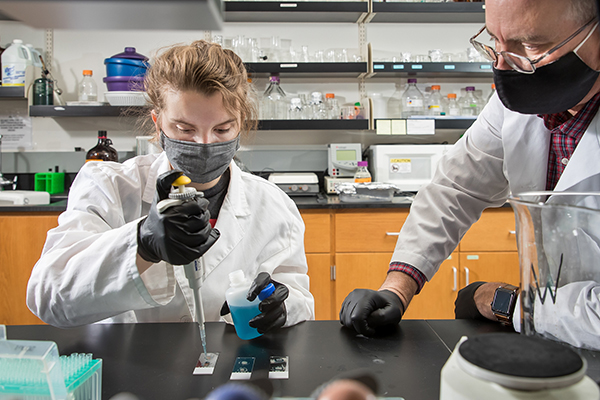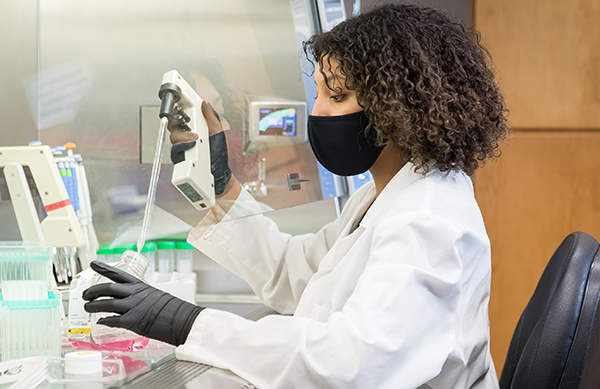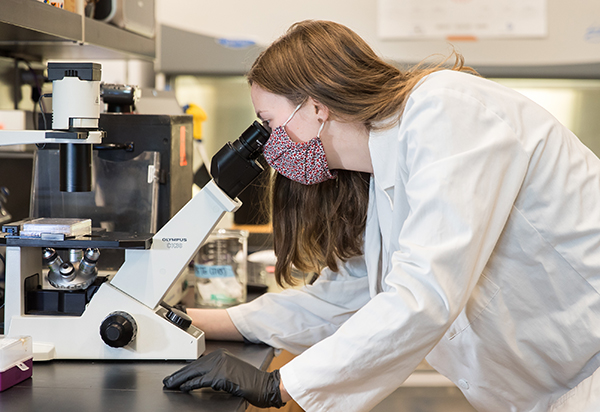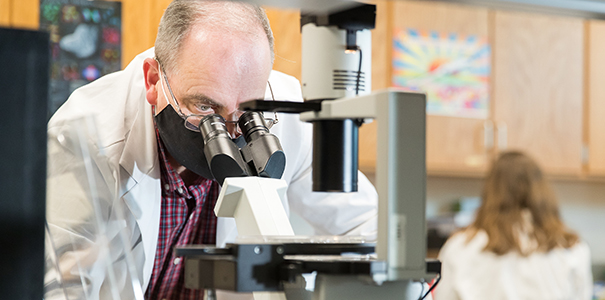
Article
February 8, 2021
Written by Katie Corder
U.S. Department of Agriculture Awards UNC Grant to Improve Pregnancy Outcomes in Dairy and Beef Cows
The U.S. Department of Agriculture’s National Institute of Food and Agriculture has awarded UNC a four-year, $500,000 grant to improve pregnancy outcomes in dairy and beef cows.
The U.S. Department of Agriculture (USDA)’s National Institute of Food and Agriculture has awarded the University of Northern Colorado (UNC) a four-year, $500,000 grant to improve pregnancy outcomes in dairy and beef cows.
Top: Patrick Burns looks through a microscope while working on the grant-funded research in his lab. Photo by Woody Myers.
The UNC Department of Biology’s Professor Patrick Burns, Ph.D., and Assistant Professor James Haughian, Ph.D., are using fish byproducts, which are rich in omega-3 fatty acids, to improve reproduction in female cows in the dairy and beef industries.

Burns (image at left) said, “There’s a critical window following mating that involves communication between a developing embryo and the mother. Reproductive biologists refer to this window as maternal recognition of pregnancy.”
To summarize: The recently conceived embryo must signal its presence to the mother, and a successful pregnancy can only establish when the signal preserves production of a pro-pregnancy hormone, progesterone, from a gland on the ovary called the corpus luteum. Progesterone from the corpus luteum in turn prompts the uterus to secrete nourishing factors that support the developing pregnancy.
Sometimes, there’s a “miscommunication” between the developing embryo and the mother, resulting in the corpus luteum dying, progesterone levels dropping and the loss of the pregnancy.
For female dairy cows, the likelihood of this miscommunication has increased, resulting in fewer pregnancies. It’s speculated that slower developing embryos miss their window of opportunity and fail to establish the maternal recognition of pregnancy. Burns and Haughian believe that omega-3 fatty acids could “extend the window” of time for perfectly healthy, yet slow growing, embryos to be recognized, resulting in more successful pregnancies.
“It’s been documented that we do see an increase in pregnancy outcomes with the supplementation of omega-3 containing fish byproducts to the diet, and we’re really interested in fine-tuning the mechanisms to make it even more efficient,” Burns said.
Because the embryo is developing slowly, the mother cow doesn’t recognize she’s pregnant, so she naturally signals from the uterus to kill the corpus luteum gland, which resets her cycle and inadvertently also kills the embryo. The uterine hormone that ultimately kills the gland and the underdeveloped embryo is prostaglandin. Supplementing omega-3 fatty acids appears to shield the gland from prostaglandin, allowing the embryo more time to develop and be recognized, resulting in more successful pregnancies.
“Because the embryo develops slowly, the mother thinks she’s not pregnant and, thus, releases the prostaglandin signal to kill the gland, and once the gland’s going, then the embryo’s also going [to die]” said Burns. “What we’re trying to do is widen this window of opportunity so that if by chance mom makes a mistake and releases the prostaglandin hormone, then we can better protect the gland from the first initial signal with the use of omega-3 fatty acids in order to give the developing embryo more time to signal to its mother that she’s still pregnant.”
If Burns and Haughian’s research proves positive, then dairy farmers and cattle ranchers could see an increase in profits that would then trickle down to consumers as cost-savings when purchasing milk and beef products.
“By increasing pregnancy outcomes, by say, 10%, this translates to an increase of profitability for American ranchers and dairy farmers in the millions of dollars in meat and dairy products,” Burns said.
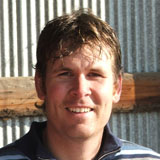
Another benefit is applying this research to other fields of biology. “You often also learn something about the way humans operate, as well,” Haughian (image at right) said. “In some ways, we know more about how we, as humans, reproduce due to work done in cattle, sheep, pigs, etc. There’s this ultimate benefit to better understand human reproductive processes.”
Burns and Haughian have partnered with Colorado State University’s Animal Reproduction and Biotechnology Laboratory to house, care and feed the animals the omega-3 rich fish byproducts for their research. They’re also conducting research in their lab at UNC with the help of numerous UNC undergraduate and graduate students.
“This gives an opportunity for undergraduates to participate in authentic research experiences and an opportunity to work with large, domestic farm animals,” said Burns. “It allows these students to get into the laboratory and develop hands-on laboratory skills.”
The research’s first trial is set to begin in March, dependent on public health guidelines due to the ongoing COVID-19 pandemic.
About the Grant
- Project Title: Influence Of Fish Oil On Corpus Luteum Function
- Grant Awards and Funding Agencies: $500,000 four-year grant from the USDA’s National Institute of Food and Agriculture
- Researchers: Patrick Burns (principal investigator) and James Haughian (co-principal investigator)
- Student Researchers: Anika Shelrud, Grace Kochman, Winford Rule, Hayley Stauber, Travis Kinn, Kathy Mireles, Aubrey Chacon, Natalia Sheppard, Allison Updike and Cam Huber

